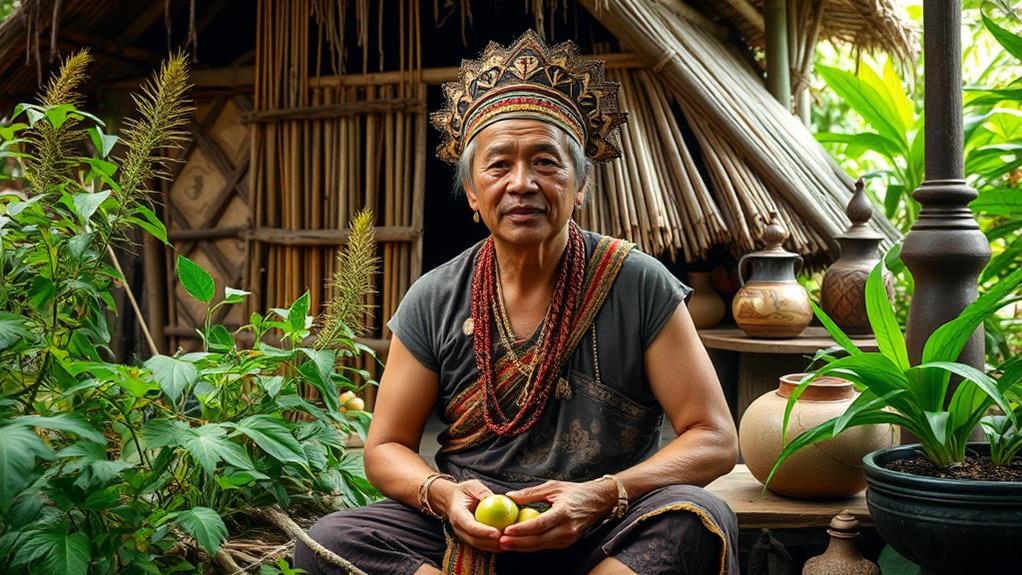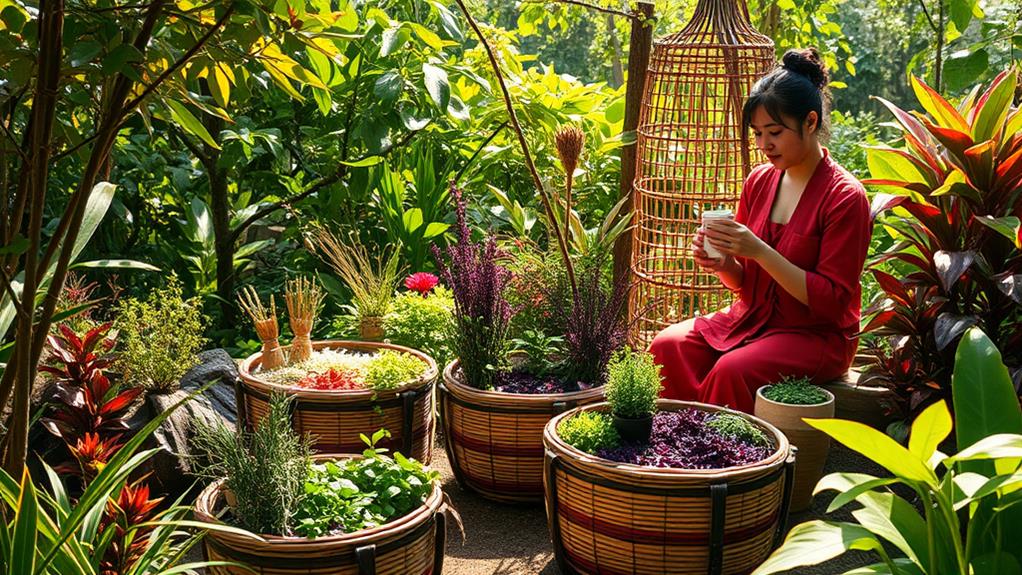Filipino healing traditions and practices are rooted in centuries of cultural heritage, emphasizing holistic well-being through various techniques.
Hilot and Ablon integrate bodywork and energy healing to promote overall wellness. These ancient rituals combine physical manipulation with spiritual connection, restoring balance to the body and mind.
Filipino herbalism is rich in tradition, with over 1,500 medicinal plants used by traditional healers called albularyos. These plants are used to create remedies for various ailments, showcasing the depth of knowledge in traditional Filipino medicine.
Tuob, a ritualistic practice, offers detoxification and relaxation through steam bathing. This ancient technique promotes physical and mental well-being, providing a holistic approach to health.
Ventosa, or cupping therapy, combines physical relief with spiritual connection. This traditional practice creates suction on the skin, stimulating blood flow and promoting healing.
In Filipino healing traditions, community plays a vital role, providing a supportive network for health and healing. This collective approach fosters a sense of belonging, ensuring that individuals receive the care and support they need.
History of Healing Traditions

The history of Filipino healing traditions dates back to the 16th century, blending pre-colonial customs with Spanish colonization. These traditional healing practices were led by babaylans, or shamans, who served as cultural, religious, and medical leaders. They believed in connecting with nature spirits to facilitate healing.
Traditional Filipino medicine is a holistic system, encompassing specialties like midwifery, herbology, and energy medicine.
Despite the rise of Western medicine in the 17th century, Filipino healing remains strong, especially in rural areas where folk medicine thrives.
The Philippines is home to a vast array of medicinal plants, with around 10,000 to 14,000 plant species, and approximately 1,500 identified for their medicinal potential.
The country's biodiversity is essential to traditional healing practices, allowing communities to harness the power of medicinal plants and preserve the wisdom of generations.
By embracing these traditions, we gain insight into the interconnectedness of health, culture, and nature.
Hilot and Ablon Techniques
Filipino Healing Traditions: Hilot and Ablon
Filipino healing traditions have evolved to include various techniques that prioritize holistic well-being. Hilot, also known as Ablon, is a traditional Filipino healing technique that combines elements of osteopathy and acupressure. This practice involves specific body manipulations designed to promote alignment and relieve congestion throughout the body.
Hilot incorporates specialized techniques, such as pekkel, which focuses on rubbing, and Ablon seated therapy, which targets the upper body. These techniques not only provide physical relief but also embody a holistic approach that intertwines physical, emotional, and spiritual well-being.
Apostol's Ablon Chirothesia, a specific form of Ablon, is particularly effective in treating back issues, sports injuries, and nerve disorders.
When you seek the guidance of a folk healer well-versed in these traditional folk practices, you're not only addressing your physical ailments but also embracing a time-honored method that connects you to the rich tapestry of Filipino culture. This healing journey offers a unique blend of care and tradition, rooted in centuries of communal wisdom.
Herbalism and Plant Medicine

Filipino Herbalism: A Rich Tradition
Filipino herbalism and plant medicine reflect a deep connection between the Filipino people and their natural environment. The Philippines is home to around 10,000 to 14,000 plant species, with approximately 1,500 possessing medicinal potential.
Traditional healers, known as albularyos, combine herbalism with spiritual practices to address various health issues. They use prayers and mysticism to create a holistic approach to traditional healing.
For example, albularyo practitioner Lyn Pacificar blends pre-colonial methods with modern insights to create herbal products that preserve the rich cultural heritage of Filipino healing.
The Philippine Department of Health recognizes 10 key medicinal plants, which are widely used in herbal applications. These plants are an integral part of the country's herbalism tradition.
The wisdom surrounding medicinal plants is a living tradition, passed down through generations.
Documentation reveals that 218 species are utilized in Indigenous healing practices, showcasing the depth of herbalism in the Philippines.
Understanding these traditions enriches one's appreciation for the profound connection between nature and health in Filipino culture.
Tuob Ritual Practices
Tuob Ritual Practices
What is Tuob?
Tuob is a traditional steaming ritual rooted in Filipino culture, offering a unique approach to health and wellness. In this ritual, participants sit over a heated jar or pot, wrapped snugly in a blanket, creating a cocoon that fosters detoxification and relaxation.
How does Tuob work?
Healers enhance the experience by applying essential oils derived from various plant species, filling the air with soothing aromas while chanting healing mantras. This combination elevates the ritual, linking physical health with spiritual well-being.
What are the benefits of Tuob?
Tuob alleviates symptoms of asthma, allergies, and arthritis, promoting skin cleansing and muscle relaxation. It emphasizes that true healing transcends the physical; it's also about nurturing one's spirit.
What role does community play in Tuob?
This practice highlights the significance of community and familial bonds in health-seeking behaviors, where loved ones often gather to support one another during the ritual.
How do Indigenous Filipino Healing Traditions and Practices incorporate Rituals and Ceremonies?
Indigenous Filipino healing traditions and practices incorporate a variety of rituals and ceremonies, rooted in their rich cultural heritage. These indigenous filipino religious rituals often involve the chanting of prayers, the use of traditional herbal remedies, and the invocation of ancestral spirits in order to restore health and balance to the individual.
Cupping Therapy and Spiritual Healing

Cupping therapy combines physical relief with spiritual healing. This ancient practice, known as Ventosa in the Philippines, involves applying heated cups to the skin to create a vacuum. This vacuum alleviates muscle pain and enhances blood circulation.
During a cupping therapy session, Filipino healers often recite whispered prayers (bulong) or orasyon to draw upon spiritual energy and invite divine intervention into the healing process. They may also ask about the origins of the discomfort, believing that physical ailments are connected to spiritual well-being.
Filipino healers may integrate plants and herbs into the cupping therapy, complementing it with natural remedies. This holistic approach demonstrates the relevance of cupping therapy in contemporary health practices, highlighting the importance of both spiritual and physical healing.
By embracing this tradition, you're not only seeking relief but also participating in a time-honored practice that nurtures both body and spirit.
Community Engagement in Healing
Traditional Healers in Filipino Communities
In Filipino communities, traditional healers, known as mananambal, provide vital healthcare services, often free of charge, to those who can't access Western medicine. This selfless act fosters strong community engagement, as neighbors visit healers' homes, building trust and interpersonal connections.
Spiritual Essence of Filipino Folk Medicine
Each healing session incorporates daily prayers and rituals, reflecting the profound spiritual essence of Filipino folk medicine.
This belief in sharing healing gifts as blessings rather than commodities enhances community bonds, reinforcing the idea that health is a collective responsibility.
Preserving Cultural Continuity
Educational initiatives encourage younger generations to engage in traditional practices, ensuring cultural continuity.
Youth learn from seasoned healers, committing to preserve this invaluable knowledge amidst modernization and tourism challenges.
Documenting and Promoting Indigenous Health Practices
By documenting and promoting Indigenous health practices, communities sustain their cultural pride and champion environmental stewardship.
Healing transcends individual needs, weaving a tapestry of connection, care, and shared heritage.
Questions and Answers
What Are the Traditional Healing Methods in the Philippines?
Traditional healing methods in the Philippines involve a combination of natural remedies, spiritual practices, and community rituals. These methods often incorporate herbal remedies, which utilize the medicinal properties of plants to treat various ailments. For example, the leaves of the lagundi plant are used to treat fever and cough, while the bark of the bittermelon plant is used to treat diabetes.
Massage techniques are also used to restore balance and promote healing. One such technique is hilot, a traditional Filipino massage that involves gentle strokes and pressure points to relieve pain and tension.
Community rituals play a vital role in traditional healing, fostering connections among individuals and promoting a sense of community. These rituals often involve shamanistic beliefs, where healers, known as albularyos, channel spiritual energy to address physical and emotional ailments.
These traditional healing methods take a holistic approach to well-being, addressing the physical, emotional, and spiritual needs of individuals. By combining natural remedies, spiritual practices, and community rituals, these methods promote overall health and wellness within the community.
What Is the Filipino Flower for Healing?
The Sampaguita is the Filipino Flower for Healing.
This fragrant blossom carries rich cultural significance and botanical symbolism in the Philippines.
It is used in herbal remedies, such as teas, to soothe stress and promote emotional well-being.
The calming properties of sampaguita connect users to feelings of love and purity, making it a cherished flower for healing.
Incorporating sampaguita into one's life can enhance their wellness journey.
What Is Spiritual Healer in Filipino?
What is a Spiritual Healer in Filipino Culture?
A spiritual healer in Filipino culture is a practitioner who channels spiritual energy to restore balance and promote well-being through healing rituals.
These rituals combine ancestral wisdom with folk medicine, addressing both physical and emotional ailments.
Healing Practices
Spiritual healers use various techniques to facilitate healing, including herbal remedies, whispered prayers, and sacred chants.
By harnessing the power of nature and its gifts, they restore balance and promote overall wellness.
Understanding of Nature and Spirituality
Filipino spiritual healers possess a deep understanding of nature and the spiritual realm.
This understanding allows them to connect with the spiritual realm, guiding individuals on a path to holistic healing and wellness.
What Are Some Traditional Healing Practices?
Traditional healing practices often incorporate herbal remedies to restore balance and promote wellness. These remedies can be found in various forms, such as teas, tinctures, and salves, and are used to treat a range of ailments.
For example, ginger has been used to alleviate digestive issues, while turmeric has been used to reduce inflammation.
Energy healing techniques, such as acupuncture and Reiki, are used to align the body's energies and foster overall wellness. These practices involve the manipulation of energy fields to restore balance and promote healing.
Acupuncture, for instance, involves the insertion of fine needles into specific points on the body to stimulate healing.
Community rituals play a significant role in enhancing the healing experience. These rituals often involve group ceremonies, meditation, or prayer, and help connect individuals seeking similar relief.
For example, some indigenous cultures hold group ceremonies to promote healing and spiritual growth.
Folk medicine, rich in cultural significance, offers unique approaches to health, blending nature and spirituality. These practices often involve the use of traditional remedies and rituals passed down through generations.
For instance, some African cultures use traditional herbal remedies in conjunction with spiritual rituals to promote healing.